|
|
|
|
|
|
|
Achi-Kochi Japan
Showing many places to visit and foods to eat in Japan
|
|
|
|
|
|
|
|
|
|
|
|
|
Japan
> Themes
> People
|
|
|
|
|
|
|
People
( Achi-Kochi Japan )
|
|
|
|
|
|
|
|
|
|
|
|
|
( "Achi-Kochi" in Japanese means "Here and there" in English. )
People
Tourists would see many people during travelling in Japan, whose population is over 125 million, such as cabin crew, railwaymen, hotel staff, chefs, salesgirls, farmers, fishermen, bank clerks, children, monks and so on. Though very few of their names could be known, they live real lives in Japan. This page shows various people whom tourists could see in Japan.
|
Invocation
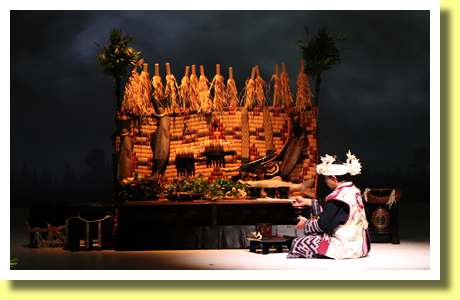
On the south bank of Akan-Ko Lake, Kushiro City, Hokkaido, there is Akan-Ko Ainu Kotan. "Ainu" is an indigenous people who live in Hokkaido and its surrounding regions, while "Kotan" is a village where Ainu people live. In the Akan-Ko Ainu Kotan, many tourists visit Ainu Theatre where Ainu people perform traditional ceremonial dances including the invocation ( above ).
There in the kotan are souvenir shops selling their unique crafts which show an aspect of Ainu traditional culture. Ainu people have their own unique language, without letters. So they inherit lots from their ancestors orally from mouth to mouth and through singing and dancing.
|
Tsugaru Jamisen
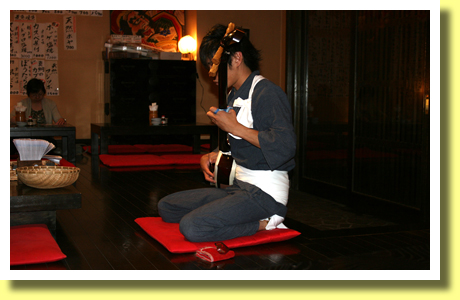
Hirosaki City, Aomori Prefecture, Tohoku Region used to be the center of Tsugaru Feudal Domain through Tokugawa Period ( the 17th-19th century ==> A History of Japan vol.2 Samurai Age ). Tsugaru Jamisen, a traditional musical instrument with three strings, and its unique playing style had developed in Tsugaru, where many people play the instruments. Tourists, staying in Hirosaki City, Goshogawara City and the surrounding area, would have opportunities to listen to the Tsugaru Jamisen performance ( above ).
|
Itaya-zaiku

Tourists could buy traditional crafts Achi-Kochi in Japan as souvenirs. Itaya-zaiku, one of local traditional crafts, has developed in Kakunodate Town, Semboku City, Akita Prefecture, Tohoku Region for a few hundred years. Tourists could see how craftman makes a Itaya-zaiku basket ( above ) in Aoyagi Samurai Manor Museum, Kakunodate Town.
Itaya-zaiku is a kind of traditional wickerwork. Its craftmen make narrow strips from Itaya Kaede ( mono maple ) and weave them to produce baskets, boxes, trays, screens and so on. Due to heavy snow, farmers could not work in the fields in winter. So Itaya-zaiku artisan craft has developed.
|
Yumomi
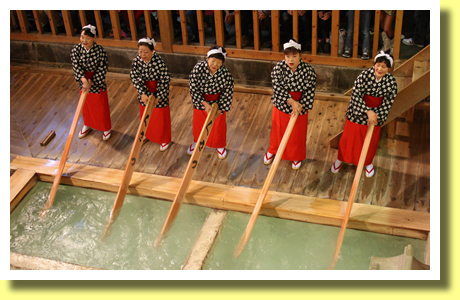
Kusatsu Onsen, Gunma Perfecture, Kanto Region, has been and is one of the most popular onsen resorts. The temperature of hot water gushing out of sources of hot springs in Kusatsu Onsen is almost 50 degrees Celsius. It is too hot for bathing. So "Yumomi" ( above ) is needed.
Cold water could be added to bring the temperature down. However it would reduce medicinal effects of hot water, they believe. So they carry out "Yumomi", stirring hot water with wooden planks, to cool it down. In Netsu-no-yu located in Kusatsu Onsen, tourists could see Yumomi, carried out to a few folk songs several times a day.
|
Nagatoro Himatsuri

On the first Sunday of March every year, Nagatoro Himatsuri ( Nagatoro Fire Festival ) is held in Nagatoro Town, Saitama Prefecture, Kanto Region. Ascetics and pilgrims parade from Nagatoro Town up to Hodosan mountain with the sound of conch shells blown. At the venue of the rites, piles of Homa sticks ( sticks on which prayers are written ) are burned. Then Ascetics run barefoot over the burning flames ( above ). Good luck and fortune are prayed for in the rites.
|
Wedding Ceremony
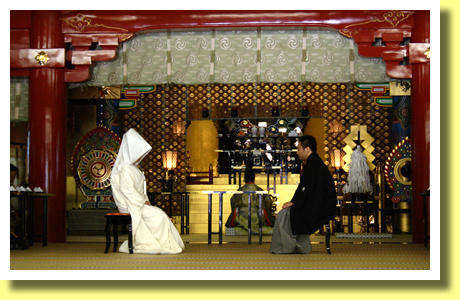
Lately most of wedding ceremonies are held in hotels, restaurants or churches in Japan. However in some cases, wedding ceremonies are held in Jinja ( Shinto shrine ) as had been. The above photo shows a wedding ceremony held in a shrine in Tokyo.
|
Kominato Beach
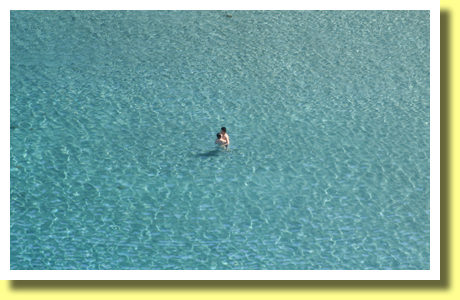
There live almost 14 million people in Tokyo Metropolis, where tourists would see so many people Achi-Kochi. However, there is a beach where only a couple was seen enjoying quietly without being disturbed. This place is a part of Tokyo Metropolis actually.
The above photo shows Kominato Beach, one of the beaches located in Chichijima, Ogasawara Islands ( Bonin slands ), which belong to Tokyo Metrololis. The Ogasawara Islands, one of UNESCO World Natural Heritage sites, have never been a part of the continent. So there live many unique and endemic animals and plants, though only a few thousand people live in the islands.
|
Hanami
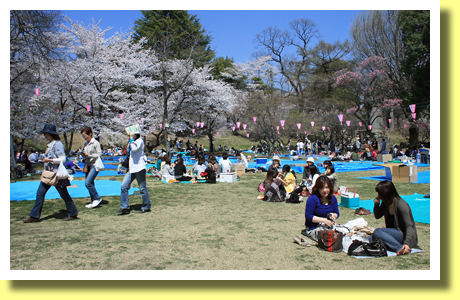
In the season of Sakura ( Cherry Blossoms ), lots of people enjoy Hanami ( Sakura Viewing ) with foods and drinks in Japan. There are many famous places where people gather for Hanami such as Ueno Park in Tokyo, Matsuyama-jo Castle in Matsuyama City and so on. Ueda-jo Castle ( above ), Ueda City, Nagano Prefecture, Koh-Shin-Etsu Region, is one of such places. Many people visit the castle site surrounded by moats where lots of cherry trees bloom in the Hanami season.
|
Gassho Zukuri

Many tourists visit Shirakawa-go, a small mountaineous village located in the north of Gifu Prefecture, Tokai Region. In the village, remain dozens of Gassho Zukuri houses as well as in Gokayama, Toyama Prefecture, Hokuriku Region. However the maintenance of such houses are far from easy. It is a hard task to secure materials and experienced manpower for rethaching ( above ).
The design of Gassho Zukuri ( Gassho Style ) houses evolved in the 18th-19th centuries and some houses in Shirakawa-go are more than 250 years old. Heavy snowfall makes thatched roofs need to be repaired every year. In addition, the entire rethatching is required once every 30-40 years.
|
Asaichi
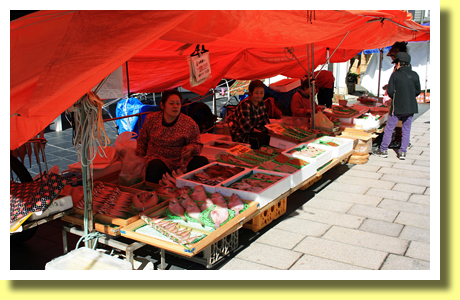
Asaichi ( Morning Market ) is one of the most famous and popular attractions in Wajima City, Ishikawa Prefecture, Hokuriku Region. In Wajima Asaichi, more than 200 stalls sell marine products ( fresh, salted and/or dried ) and vegetables. Most of the stalls are run by wives of fishermen and farmers ( above ).
It is said that Wajima Asaichi has more than 1,000 years of history. Wajima Asaichi is held in the center of the city, through 8:00 AM - noon everyday except the 2nd and 4th Wednesday every month. There is a hut where BBQ grills for tourists are ready through 8:30 AM - 11:30 AM. So dried fish bought in Asaichi could be BBQ grilled. Also there are some shops selling cans of beer and/or sake.
|
Katsura Rikyu
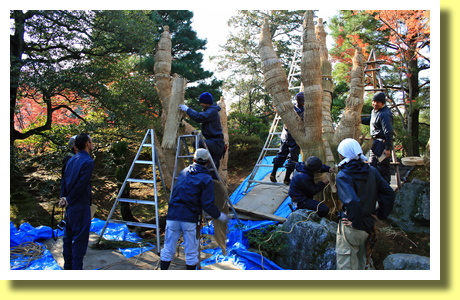
Katsura Rikyu ( Katsura Imperial Villa ) is one of Palaces, Villas, temples and shrines related to the Imperial Family, which remain in Kyoto even after the Emperor Meiji moved to Tokyo in A.D.1868. Katsura Rikyu was built by two Imperial Princes and completed in A.D.1645. Its garden, one of the most beautiful Japanese gardens, has been and is looked after by many gardeners ( above ).
|
Nama Maguro
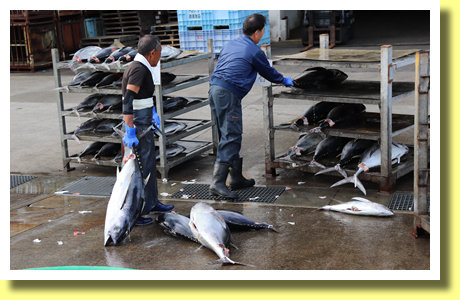
Nachi-Katsuura Town, a part of Kumano, Wakayama Prefecture, Kinki Region, has a commercial fishing port which is famous for the largest catch of Nama Maguro ( ocean-fresh tuna ). The above photo shows those who are carrying Nama Maguro from fishing boats to the fish market, around which there are dozens of restaurants serving various Nama Maguro dishes. So Nachi-Katsuura Town would be one of the best places for tourists to enjoy Nama Maguro dishes.
Also Kumano Nachi Taisha, Nachi Waterfall, Seiganto-ji Temple and Fudarakusan-ji Temple are located in Nachi-Katsuura Town. All of them are included in UNESCO World Heritage Site " The Sacred Sites and Pilgrimage Routes in Kii Mountain Range".
|
Okonomi-yaki
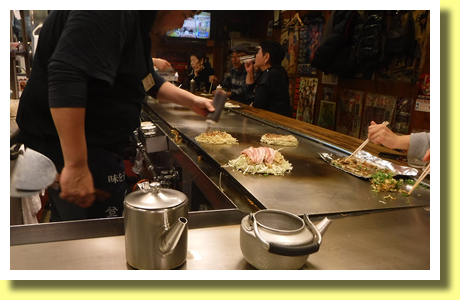
There are a few thousands of Okonomi-yaki restaurants in and around Hiroshima City, Hiroshima Prefecture, Chugoku Region. So there are so many people cooking and eating Okonomi-yaki ( above ). They say that Okonomi-yaki is the soul food of Hiroshima.
In Hiroshima, Okonomi-yaki is thin flour dough cooked on an iron plate with layers of various ingredients such as sliced pork, shrimps, squids, egg, cabbage and/or noodles. In Osaka, which is also famous for Okonomi-yaki, flour dough mixed with ingredients without making layers, is cooked on an iron plate.
|
Ta-ue
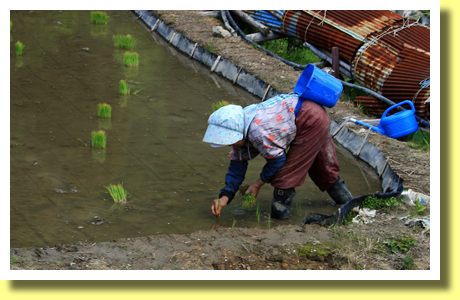
Rice farming had been the most important industry in Japan for a few thousand years and even now it is one of important industries. So tourists would see Ta-ue ( rice planting ) Achi-Kochi throughout Japan in spring. Though many agricultural machines are used now, small paddy fields in mountains are not suitable for machinery. So rice plants are set out in some cases without machinery as above photo, which was taken in Yusuhara Town, Kochi Prefecture, Shikoku Region.
|
Katsuo Tataki

The above photo shows a cook roasting a Katsuo ( bonito ) fillet over a fire fueled with straw. When the surface of the fillet is seared with its center remaining raw, the Katsuo fillet is plunged in iced water and sliced. Then slices of Katsuo fillet is served with salt or sauce made from shoyu ( soy sauce ) and citrus, raw garlic, onion and so on. Then Katsuo Tataki, the most famous specialty dish of Kochi Prefecture, Shikoku Region, is ready.
|
Jigoku Mushi
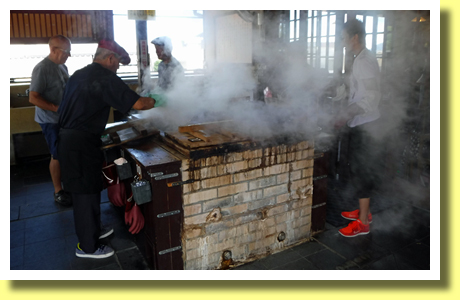
Beppu Onsen, located in Beppu City, Oita Prefecture, Kyushu Region, is one of the most famous and popular onsen hot spring resorts. In Beppu Onsen, hot springs are utilised not only for bathing but also for Jigoku Mushi cooking. There are some facilities where tourists could enjoy Jigoku Mushi cooking by themselves ( above ).
Various ingredients ( seafood, pork, chicken, eggs, vegetables and so on ) are cooked in the high temperature steam blowing out of natural hot springs. It is Jigoku Mushi cooking, unique to Beppu Onsen. There are many restaurants serving Jigoku Mushi dishes.
|
Copyright (c) 2023 Achi-Kochi Zanmai Co., Ltd.
|